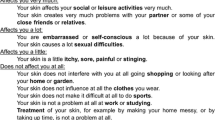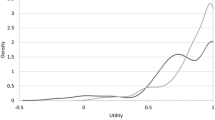Abstract
In many countries, utility measures are required for allocation decisions. Unlike the EuroQoL-5D (EQ-5D), the dermatology life quality index (DLQI) has not been developed for the derivation of utilities. Purpose of this study was to develop and test an algorithm for the transformation of DLQI scores into utilities. Pre-existing data of two cross-sectional studies (for development, n = 1,511; for cross-validation n = 2,009) of German psoriasis patients were reanalyzed. Both EQ-5D global score and EQ-5D visual analogue scale (VAS) were used as utility measures. Correlations were computed to identify predictors of EQ-5D utilities. Linear stepwise regressions were conducted using DLQI and further possible predictors to find the optimal mapping algorithm. Using only DLQI as predictor resulted in coefficients of determination of r 2 = 0.235 (EQ-5D global score) and r 2 = 0.242 (EQ-5D VAS). In the final algorithm, seven predictors were included which correctly predicted EQ-5D VAS for 60.4 % (development database) and 60.8 % of all patients (cross-validation database) within a range of ±15 units. The algorithm explained 31.3 % of the EQ-5D variance in the development database and 26.8 % in the cross-validation database. In conclusion, mapping of DLQI on EQ-5D in psoriasis patients has severe limitations in validity and clinical relevance.



Similar content being viewed by others
References
Augustin M, Amon U, Braathen L et al (2004) Empfehlungen zur Erfassung von Lebensqualität in der Dermatologie [Recommendations for the assessment of quality of life in dermatology]. J Dtsch Dermatol Ges 2:802–806
Augustin M, Kruger K, Radtke MA et al (2008) Disease severity, quality of life and health care in plaque-type psoriasis: a multicenter cross-sectional study in Germany. Dermatology 216:366–372
Augustin M, Reich K, Reich C et al (2008) Quality of psoriasis care in Germany–results of the national study Psoriasis Health 2007. J Dtsch Dermatol Ges 6:640–645
Bakker C, van der Linden S (1995) Health related utility measurement: an introduction. J Rheumatol 22:1197–1199
Currie CJ, Conway P (2007) Evaluation of the association between EQ5D utility and dermatology life quality index (DLQI) score in patients with psoriasis. Value Health 16:A470
Finlay AY, Khan GK (1994) Dermatology life quality index (DLQI)—a simple practical measure for routine clinical use. Clin Exp Dermatol 19:210–216
Greiner W (2012) Der EQ-5D der EuroQol-Gruppe In: Gesundheitsökonomische Evaluationen (Schöffski O Graf von der Schulenburg, JM eds). Springer, Berlin, pp 411–422
Greiner W, Weijnen T, Nieuwenhuizen M et al (2003) A single European currency for EQ-5D health states. Results from a six-country study. Eur J Health Econ 4:222–231
Norlin JM, Steen Carlsson K, Persson U et al (2012) Analysis of three outcome measures in moderate to severe psoriasis: a registry-based study of 2450 patients. Br J Dermatol 166:797–802
Schmitt J, Wozel G (2005) The psoriasis area and severity index is the adequate criterion to define severity in chronic plaque-type psoriasis. Dermatology 210(3):194–199
Schulenburg vdJ, Claes C, Greiner W et al (1998) Die deutsche Version des EuroQoL Fragebogen [German version of the EuroQol questionnaire]. Zeitschrift für Gesundheitswissenschaften 11:3–20
The EuroQol Group (1990) Euro Qol—a new facility for the measurement of health related quality of life. Health Policy 16:199–208
US Department of Health and Human Services (2009) Food and Drug Administration (FDA) Guidance for industry—patient-reported outcome measures: use in medical product development to support labeling claims. http://www.fda.gov/downloads/Drugs/GuidanceComplianceRegulatoryInformation/Guidances/UCM193282.pdf. Accessed 17 Dec 2012
Zentner A, Velasco-Garrido M, Busse R (2005) Methods for the comparative evaluation of pharmaceuticals. HTA report. GMS Health Technol Assess Doc09 (20051115) German Agency for Health Technology Assessment (DAHTA)
Acknowledgments
This project has been supported by a research Grant from Janssen-Cilag GmbH, Neuss, Germany.
Conflict of interest
None.
Author information
Authors and Affiliations
Corresponding author
Rights and permissions
About this article
Cite this article
Blome, C., Beikert, F.C., Rustenbach, S.J. et al. Mapping DLQI on EQ-5D in psoriasis: transformation of skin-specific health-related quality of life into utilities. Arch Dermatol Res 305, 197–204 (2013). https://doi.org/10.1007/s00403-012-1309-2
Received:
Revised:
Accepted:
Published:
Issue Date:
DOI: https://doi.org/10.1007/s00403-012-1309-2




